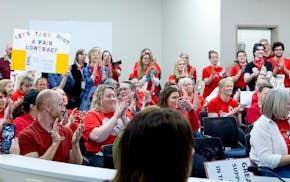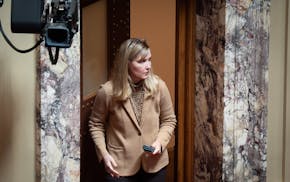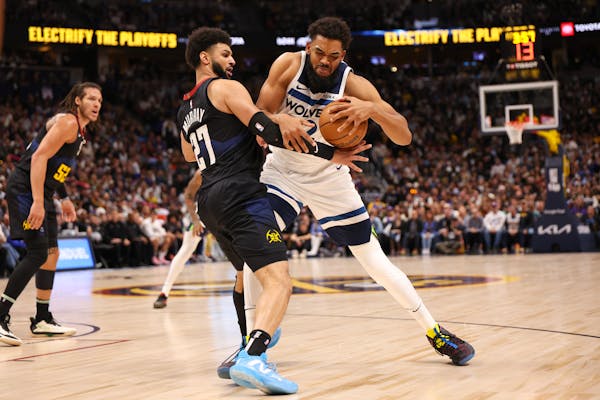Last August, Troy Kester reported four broken streetlights on W. Broadway to Minneapolis' 311 hot line. The city didn't fix them until spring.
"The fact that there's a whole string of messed-up lights doesn't send a good message to the people driving through," he said.
Minneapolis is reviewing its streetlight system after noticing in municipal surveys that residents of north Minneapolis — where Kester reported the lights — and the Phillips community in south Minneapolis report dramatically lower rates of satisfaction with their lighting than anywhere else in the city. Those areas also have higher poverty and crime.
"Is it a perception issue?" Steve Kotke, public works director, asked City Council members during his reappointment hearing last month. "Is it a reality issue? It's those types of things that aren't always apparent that we need to drill down into … and [learn] where we are unintentionally causing some racial inequities."
Requests to repair broken streetlights are surging across Minneapolis, jumping 46 percent in the last year and costing $1.2 million to fix. A city report found funding levels have not kept pace with increasing costs for the repairs.
Streetlight maintenance also is among the basic municipal services that Mayor Betsy Hodges included in a directive to department leaders to examine whether they are providing services equally across the city when she took office in January.
Hodges, who campaigned on a theme of improving racial equity, reiterated the importance of that following an April 5 Star Tribune report where city data showed complaints about potholes were resolved more quickly in the affluent Southwest and Nokomis communities than anywhere else, including lower-income areas of north and northeast Minneapolis. Public works officials attributed disparities to differences in data entry methods, but Hodges said either way, different service levels in different parts of town is unacceptable.
Minneapolis took a more proactive approach to streetlight repairs until state aid cuts about a decade ago, according to Jon Wertjes, director of traffic and parking services. Now, four crews of electricians largely keep the lights shining by reacting to residents' complaints.
"We're not driving the city looking for it, so we are … dependent on these calls," said Wertjes.
Concerned that just reacting to complaints could foster unequal service around the city, Minneapolis is looking toward Seattle as a model.
Years ago, Seattle faced a backlog of thousands of citizen requests to fix streetlights and noticed that people in poorer communities sometimes reported them less. The city moved from a complaint-driven repair system to scheduling each quadrant of the city for streetlight replacements every four years.
"You'll find that the complaints originate primarily from those that feel empowered, those that think that they have influence. … I think every utility and community out there wrestles with the same problem," said Steve Crume, streetlight engineering manager for Seattle's municipal utility.
Improving repair times
Minneapolis has 40,000 lights, but only about 18,000 are owned by the city, distinguished by their metal poles and concentrated downtown and in commercial corridors. The rest, on wooden poles, are owned and maintained by Xcel Energy. The Central, University and Calhoun-Isles communities have the most city-controlled lights, and two-thirds of the requests for repair originate there.
Citizens made more than 5,400 requests to repair city streetlights in the last five years, records show, and it took 17 days on average for Minneapolis to report closing a complaint. Average times have improved over that period to more than 14 days last year, and a city report found that most repairs now are made within 12 days of a person's request. Car crashes, snowstorms and underground wiring problems can all substantially delay repair times.
Records show that complaints about streetlights in Southwest — the wealthiest, lowest-crime community in Minneapolis — were resolved more quickly than anywhere else with an average of 12 days. That's despite the Central, Calhoun-Isles and the University communities all having significantly more streetlights, more requests for repair and higher crime rates.
Near North and Powderhorn — which have slightly more streetlights than Southwest but called in fewer complaints about them — were tied for having the slowest repair time of 22 days, according to the 311 reports. In the Central community spanning downtown, which had the most repair requests and lights, it took an average of 17 days.
Wertjes said that most lights in Southwest are new fixtures along Nicollet and Lyndale Avenues, which usually just need quick bulb replacements, or parkway lights around the lakes and creek, which receive fewer crashes that would cause longer repair times.
He added that 15 requests in Near North resulted in a major replacement with considerable repair times that skewed the average, saying that otherwise repair times were consistent with the rest of the city. With Kester's complaints, a car crash into the poles required major fixes, and high workloads caused further delay, according to Wertjes. Frequent light spacing along West Broadway also led the team to prioritize other work.
The city's pilot study of citizens' lighting perceptions, and how the city can improve the lights, will dig deeper into what's happening in Near North, where residents rate their satisfaction with street lighting at 59 percent. That's lower than any of Minneapolis' 12 communities. More than 80 percent of citizens are happy with their street lighting in all but the Camden, Phillips and Near North communities.
As for installing more lights? That has drawn backlash even among more affluent residents, given the city's policy that property owners be assessed for the cost of new lights in street construction projects. Southwest residents last year rejected a $600,000 proposal to build new lights on Penn Avenue. An initiative that started last year will have the city foot the cost of lights in areas heavily traveled by pedestrians.
Minneapolis is crafting a plan for its next budget to join Seattle and other big cities worldwide in switching to more energy-efficient LED streetlights, which are already being tested on 46th Street in south Minneapolis. A larger conversion would cost millions but also last up to a decade longer than the city's traditional high-sodium lights — and ease the strain on repair crews.
Maya Rao • 612-673-4210

Lakeville teachers, district reach tentative contract agreement

Pulitzer Prize winner Hernan Diaz, Oscar-anointed Percival Everett and bestseller Rebecca Makkai coming to Hopkins for Pen Pals

Meet the affordable housing champion fighting for St. Paul's West Side

